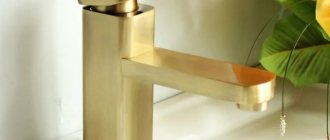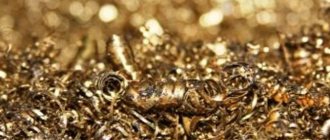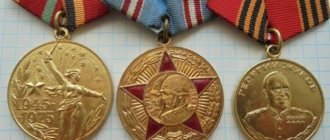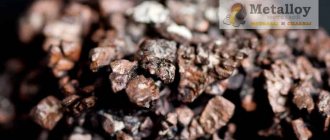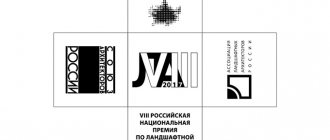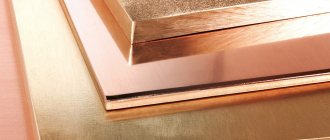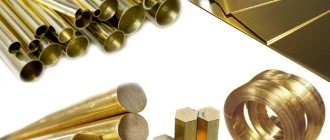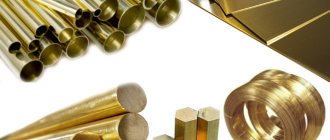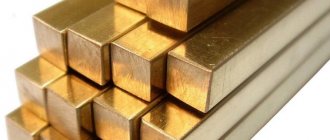Characteristics of metals
Bronze is an alloy of copper and tin, silicon, beryllium, aluminum, lead and other elements.
However, only tin is often used to obtain high-quality bronze. There are also alloys that use nickel and/or zinc. They are called spiater and are a cheap analogue of bronze. Depending on what metal is present in the alloy, bronze is distinguished: Thanks to this variety, the material is divided into two large groups - tin and tin-free. Previously, arsenic bronze also existed, but it was not widely used.
Brass is also an alloy, but here the main element is zinc combined with copper , to which nickel, tin, lead, manganese, iron or other elements may sometimes be added. Already in Ancient Rome, methods for producing this alloy were known. The Romans learned to smelt copper with zinc ore. It was only in 1781 that zinc in its pure form began to be used in England to produce brass. In the nineteenth century, due to its special color, this metal began to be used as counterfeit gold, and this quickly spread to many countries.
Currently, such an alloy is used to produce steel-brass bimetal. It is resistant to corrosion and abrasion, and is also quite flexible. In addition to the fact that brass is used in industry, its variety, called tombak, is quite often used for the manufacture of fittings, artistic products and insignia.
Stainless steel.
It is resistant to corrosion in aggressive environments. This is its main property. The alloy is subjected to alloying; the main alloying element is chromium, and the more of it, the more resistant the steel is to the corrosive effects of, for example, acids. The chromium content can be from 12 to 20% (if chromium is 17 percent or more, the alloy will withstand exposure to 50% concentration of nitric acid). To enhance this wonderful property of stainless steel and give it additional physical and chemical properties, it is also alloyed with nickel, titanium, niobium, and molybdenum. The ratio of certain elements and their quantity determines the grade of steel and its resistance to strong acids (phosphoric, sulfuric, etc.)
How to explain such corrosion resistance? At the interface of the chromium-containing alloy and the medium, a film of oxides and other insoluble compounds forms, which protects the surface. Many different products are made from stainless steel. And not only in industry. It is not only durable, but also aesthetically pleasing material - it is used very often in architecture and in the design of household items.
Comparison of two metals
As mentioned above, copper is used to make bronze and brass.
However, its combination with tin or zinc produces alloys that have different properties and are used in different fields. For example, bronze is considered a material that sculptors like to use to create busts, fences, monuments and other solutions that require durability and beauty. Brass is practically not used for such purposes; it is only occasionally used to create some kind of artistic products. The reason is the plasticity of the metal; it wears out quite quickly, while bronze monuments can stand for centuries.
An interesting fact is that bronze products have been used in maritime affairs since ancient times.
They remarkably withstand the negative effects of salt water , while pure brass is completely incapable of this.
To achieve certain properties, alloying with aluminum, lead or tin is required. The appearance of these alloys is also slightly different. Bronze has a coarse-grained dark brown structure. Brass is much lighter; due to its characteristic yellowness, it resembles gold, and its structure is fine-grained.
In addition, both alloys are divided into different groups:
- brass can be two-component or multi-component;
- bronze - tin and tinless.
Aluminum or brass what to choose
Plates are made from different materials, the choice of which is entirely a matter of taste and preference of the customer.
Some are ready to be content with inexpensive plastic just to indicate their location to clients, while others make the sign one of the elements of their company’s PR campaign and therefore carefully select the material. Plastic, of course, will not suit such a customer. It is best to order a sign made of metal. But metal can be different, each type has its own characteristic features that must be taken into account. The most common are brass signs and aluminum signs.
The main advantage of the former is their visual appeal and long service life. However, brass signs require very serious maintenance. Especially if they are placed outdoors or in rooms with high humidity. Under such conditions, brass oxidizes and corrodes, traces of which can only be removed with serious effort. Moreover, this will have to be done periodically.
In addition, since brass is a heavy metal, signs made from it require serious fastening. You can't do it without screws. To make the fastener heads less noticeable against the general background, you can use bolts and screws made of the same metal or disguise them on top with special plugs.
In this regard, aluminum signs are much easier to use. This material is resistant to moisture, has a pleasant silver color and shine, which remain even after several decades of use. Glossy aluminum signs can be easily cleaned from dirt, making them ideal for outdoor placement. Due to their lightness, such signs are easily attached to walls and are held in place even with ordinary double-sided tape. Therefore, if you need a sign on the wall, drilling of which is unacceptable, then without hesitation you should opt for duralumin.
Another big plus of aluminum signs is that they leave a huge scope for creativity. Modern equipment allows us to make signs from this metal of any shape and size, which in no way affects their quality. The smooth surface of duralumin signs perfectly holds the self-adhesive film, thanks to which you can make bright and colorful stands with any information. This, as well as the affordable price of aluminum, make such signs more and more popular. Today they can be found not only on facades, but also in factory workshops. And in a variety of enterprises, and in educational, cultural and medical institutions.
Source
The difference between the two metals
The difference between these two alloys is as follows:
- Bronze is obtained by alloying copper with tin. In addition, this alloy contains impurities of metals such as lead, aluminum, beryllium, silicon, etc. Brass is obtained by fusing copper with zinc. Iron, nickel, manganese, lead, etc. are also added to this alloy.
- Bronze is a dark brown metal with a coarse grain structure, while brass is yellow in color and is quite smooth and fine grained.
- When interacting with sea water, bronze products do not deteriorate at all, but brass products may suffer. This property of alloys is taken into account in the construction of ships and the manufacture of various fishing accessories.
- Bronze is divided into tin and tin-free groups, and its opponent is divided into two-component and multi-component.
- Bronze products are much stronger than brass and they are much more resistant to wear.
- Bronze is often used to make fences, monuments and a variety of metal interior decorations. Brass is also used to make various jewelry and decorative elements, but quite rarely. But it is used to create steel-brass - a fairly practical bimetal that is not prone to rust.
Thus, it is not so easy to distinguish bronze from brass. It’s not easy to do this at home, but it’s possible. You just need to carefully examine both alloys , which are located in the same place. If you pick them up, bronze will be much heavier than brass, and its color will be much darker.
Source
How to tell - copper or brass?
Before starting a comparative analysis, it is necessary to clean the metal from dirt and patina. There are ways to tell the difference at home without using tools. But it is better to reliably determine whether it is an alloy or a metal, using a number of possible methods.
As for the shade, the difference may be small for materials such as copper and brass. It all depends on the level of metal content in the alloy. However, there are still differences. First of all, you need to completely clean the object under study from dirt. Studying should be done under bright, white lighting. Either sunlight or fluorescent light will do.
Copper will have a brown tint with a red or pinkish tint. The color range of brass lies in yellow tones. However, to be completely sure, it is better to take an item that is definitely made of copper and visually compare its color with the shade of the object being studied.
How to identify copper or brass by sound? If the object is large enough, then this is one of the simplest and most accurate methods of analysis. You need to hit the object with some metal thing and listen carefully to the pitch of the sound. Copper, as a softer material, will produce a lower, even dull sound. Brass, on the contrary, will sound loud and high.
Hardness
How to test brass at home? It is enough to hit it with a hard object. Metal without impurities is softer and will be deformed. The alloy, on the contrary, will withstand all blows. After all, brass was created in order to give rigidity to flexible copper.
Read also: Consumption of acetylene and oxygen when cutting metal
Marking
If we are talking about a separate product, then there is often a marking on it. It will give accurate information about the composition. Copper items are designated by a combination of letters, the first of which is “M,” and for brass items, “L.” In the USA, brass is marked C2, C3 or C4. In the European Union, the first letter of the label will always be S. However, there are a few more points that will help determine the composition of the item. The following are important:
- Copper is designated by the symbols A,B,C,D.
- On things that consist of an alloy, the letters L, N, M, P, R are indicated.
- If the product has Cu Zn symbols, then it is also brass.
Weight and density
What is heavier - copper or brass? The alloy will be lighter than metal without impurities. But if the subject being studied is small, then it will not be possible to do without scales.
Chip shape
What are the differences between brass and copper in chips? Since the alloy is harder, the chips, accordingly, will be sharp, needle-shaped, and crumbly. Similar to grated carrots. As for copper, its shavings are spiral and circular. Similar to the peel of a peeled apple. However, for comparison you need to have access to the machine.
Acid analysis
Brass is an alloy of what metals? Copper and zinc. However, if the copper content is above 96%, then all the above methods will not help distinguish pure metal from an alloy. In this case, hydrochloric acid will come in handy. If you drop it on metal without impurities, there will be no reaction. Only the patina will come off. However, due to the fact that it contains zinc, brass will develop a white oxide.
Analyzers
This is one of the most expensive, but at the same time reliable methods for determining the composition of a material. Such a device, reacting with metal, displays detailed information about its constituent parts on the liquid crystal screen. In this way, it will be clear whether the object being studied contains any impurities, or whether it consists of 99% or more percent copper.
Heating
The melting point of copper and brass is different. However, even without melting the metal, you can find out about its composition. For this method, you need to prepare a gas burner. You need to heat the object to a temperature of 600 degrees. Zinc oxide will appear on the alloy in the form of a pale, ashy coating.
Along with these two metals, bronze is often used. It is an alloy of copper with tin, aluminum, silicon and other substances. How to distinguish copper from bronze and brass? The methods are the same. The main thing is to know the distinctive features of bronze. First of all, it is very strong; some alloys are stronger than steel. Bronze items are much less susceptible to corrosion and have a different shade.
Where are copper and brass used?
There are items that are made only from pure copper, and there are those for which brass is better suited. The reason is the different physical properties of these materials. If an object is supposed to be strong, hard, rigid (for example, a tool), then with a 95% probability we can say that it is made of brass. And if flexibility and high electrical and thermal conductivity are required, then copper is used. It is impossible to say which is better - copper or brass: each of the materials adequately performs its functions.
Copper is most often used to make wires. The thermal conductivity of brass and copper is different. It is a pure alloy that can provide a high speed of electrical current.
Due to its ductility, copper is in demand for wire production. It has high strength indicators. Copper wire is used in such industries as electrical engineering, power generation, shipbuilding, and automobile production.
Copper pipes are highly valued because they have unique properties. They are resistant to temperature changes and are not afraid of ultraviolet radiation. Moreover, there are technologies that make it possible to make copper pipes seamless with a round cross-section. They are actively used for transporting liquids and gases.
Copper is also used in the construction industry for roofing. At the same time, the patina, which appears after some time, acts as a certain protective screen that protects the roof from temperature changes, aggressive effects of moisture and sunlight.
As for brass, this is also a very popular material. First of all, it is an ideal metal for the production of sanitary ware. The fact is that brass does not rust due to constant exposure to moisture, but only darkens. And this plaque can be removed without any problems. Therefore, brass faucets, pipes, taps are invariably in high demand.
Brass screws, bolts and nuts are prized. They are strong and durable. In addition to technicians, brass is also held in high esteem by creative individuals. It is used to create magnificent jewelry, interior items, and is used to create decorative elements and fittings for windows and doors. Brass is even called the “eternal metal” because it retains its original appearance for a long time.
How to choose copper and brass products?
In order not to be disappointed in the purchase, you should decide in advance for what purposes the product will be used.
Important! Purchases should only be made in stores with a proven reputation. Situations often arise when a copper item turns out to be a fake with sputtering, or a brass item contains too many foreign impurities.
It is not so difficult to distinguish copper products from brass ones. It is important to carefully examine the metal object using the proposed analysis methods.
What is bronze?
Before we figure out how to distinguish bronze from brass, let's find out what each alloy is. Let's start with bronze. So, bronze is an alloy of tin and copper, with admixtures of silicon, aluminum, beryllium and lead. It is the quality of the tin used that largely determines the nature of the future alloy.
There is a special type of bronze, in the manufacture of which tin is replaced with nickel or zinc. This alloy is known as spiatr. Essentially, the material is a cheap version of bronze, which is not of the best quality.
According to the above manufacturing principles, bronze is divided into tin and tin-free. At the beginning of the last century, metallurgists produced arsenic bronze. However, due to its high toxicity, the material was never widely used.
Recommendations for selection
The cost of silumin products is lower than brass, so many users purchase budget products. Even if devices made from an alloy of aluminum and silicon are treated with care and shocks are avoided, destruction inside the housing can occur due to a water hammer in the water supply system.
Silumin cranes are used for no more than 1.5 - 2.5 years and, most often, cannot be repaired. They are installed in temporary cabins, trailers, and dachas.
Brass faucets are of high quality and are used in bathrooms of apartments and private houses. The products are designed to last for a long time; gaskets and valve axle boxes are replaced in them, so we can talk about the possibility of repair.
What is brass?
Brass is practically the same alloy as bronze. But instead of the alloying composition in the form of tin, zinc is used here in combination with copper. Sometimes lead, iron, nickel, manganese, and other elements are added to the alloy.
The ancient Romans knew how to produce brass. They were the first to learn how to combine molten copper with zinc ore. Pure zinc began to be used for the production of brass only at the end of the 18th century in Britain. The British often used the alloy to create fake gold, because brass, like a noble metal, has an attractive sunny shine.
Today the material is widely used to create the so-called bimetal - an alloy where steel is combined with brass. This solution contributes to the production of metal that is resistant to corrosion and abrasion. At the same time, bimetal products have good ductility.
The essence of materials
These metals are widely in demand today in the industrial sector. The color of brass and bronze of individual brands may be similar. However, they may differ in some of their properties. Bronze has been used by people for many thousands of years. Initially, bronze alloys were made, based on tin and copper. The metallurgical industry gradually developed, and people learned to exchange tin for other elements, such as iron, for example, or lead. Silicon, aluminum or beryllium and phosphorus could also serve as worthy alternatives. Depending on which basic materials were used, bronze can be:
Stainless steel.
It is resistant to corrosion in aggressive environments. This is its main property. The alloy is subjected to alloying; the main alloying element is chromium, and the more of it, the more resistant the steel is to the corrosive effects of, for example, acids. The chromium content can be from 12 to 20% (if chromium is 17 percent or more, the alloy will withstand exposure to 50% concentration of nitric acid). To enhance this wonderful property of stainless steel and give it additional physical and chemical properties, it is also alloyed with nickel, titanium, niobium, and molybdenum. The ratio of certain elements and their quantity determines the grade of steel and its resistance to strong acids (phosphoric, sulfuric, etc.)
What is more expensive, brass or bronze?
The cost of metals on the market is almost the same. In some collection points the price of bronze may be higher than brass alloys, in others it’s the opposite. If you want to know the cost, go to the "Sell Scrap Brass" section. Considering the average market value, we can note:
- Increased demand for brass. This metal is more often used for the manufacture of household products, plumbing equipment, pipes and other common goods.
- Components. Brass alloys are mainly made using zinc, bronze alloys - with tin and a number of other additives.
- Characteristics. With properties and physico-chemical data it is more difficult. Here the parameters depend on the percentage of copper content and additional components.
Considering these factors, the demand and composition of brass metals is more in demand, therefore the average price of this metal is 10–20 rubles per kg higher than that of bronze scrap.
What is stronger, brass or bronze?
When comparing maximum permissible loads, wear resistance and other parameters, it is important to consider that the characteristics are affected by the composition of the alloys. For comparison, it is worth taking the highest grade metals. This will help you find out how brass differs from bronze in terms of physical and chemical parameters. Having studied the data, you can note:
- Bronze is heavier. The reason is the presence of tin. Its mass is greater than that of zinc.
- The corrosion resistance of brass is lower. Bronze can come into contact with salt water with little or no effect, but brass alloys must be alloyed to reduce the effects of corrosion.
- The wear resistance of bronze products is higher, since the metal has a lower coefficient of friction.
Based on these properties, it can be noted that bronze is stronger than brass when considering equally high-quality alloys.
Stainless steel.
It is resistant to corrosion in aggressive environments. This is its main property. The alloy is subjected to alloying; the main alloying element is chromium, and the more of it, the more resistant the steel is to the corrosive effects of, for example, acids. The chromium content can be from 12 to 20% (if chromium is 17 percent or more, the alloy will withstand exposure to 50% concentration of nitric acid). To enhance this wonderful property of stainless steel and give it additional physical and chemical properties, it is also alloyed with nickel, titanium, niobium, and molybdenum. The ratio of certain elements and their quantity determines the grade of steel and its resistance to strong acids (phosphoric, sulfuric, etc.)
How to explain such corrosion resistance? At the interface of the chromium-containing alloy and the medium, a film of oxides and other insoluble compounds forms, which protects the surface. Many different products are made from stainless steel. And not only in industry. It is not only durable, but also aesthetically pleasing material - it is used very often in architecture and in the design of household items.
Laser cutting of stainless steel
Laser cutting of aluminum
Laser cutting of copper
Laser cutting of brass
This is the most common non-ferrous metal. Resistant to corrosion in the air (only carbon dioxide contained in the air forms a greenish coating - patina), in fresh and salt water, with alkaline solutions, but dissolves in strong acids (nitric, sulfuric). It is easily processed by soldering and pressure, but its casting properties are not very high. Deoxidized and oxygen-free copper is used in electronics.
Copper alloys are wear-resistant, just like pure copper is anti-corrosion.
Based on the interaction of copper with impurities, 3 groups are distinguished:
- Solid solutions: with aluminum, zinc, antimony, nickel, tin, iron (electrical and thermal conductivity decreases);
- Insoluble impurities: bismuth, lead (electrical conductivity does not change, but pressure treatment is difficult);
- Brittle chemical compounds: sulfur and oxygen (oxygen reduces strength, and sulfur promotes better cutting).
Copper and copper alloys have long been used to this day in the manufacture of dishes, household items, and are used in art and architecture.
Comparative characteristics and differences between metals
In the metallurgical industry, there are clear criteria for distinguishing between bronze and brass. However, if a person is not associated with this field of activity, he will not be able to determine by eye what material is in front of him. Combining copper with tin or zinc produces alloys that have different properties and are used in specific areas.
Bronze and brass have different properties and belong to completely different categories. The first alloy can be tin or tin-free, while the second can be two- or multi-component.
Bronze alloy consists of tin to which lead may be added. The color of the metal will depend on the percentage of one element or another. The main additive element in brass is zinc.
Bronze is resistant to chemical and aggressive compounds. In addition, its negative reaction to salty sea water made it possible to use the alloy in shipbuilding and navigation. Brass cannot boast of this, so to give it improved qualities, additional elements must be introduced into the alloy. In addition, bronze has better strength and anti-friction characteristics than brass. This allows you to significantly expand the scope of application of the alloy.
The high zinc content in brass gives the alloy a variety of colors from pink-red to golden yellow. This is what makes it similar to noble gold.
The silvery-white color of bronze is achieved by adding more than 35% Sn to its composition. An alloy containing at least 85% copper is brownish-red in color. Since compounds with high levels of impurities are rare, it can be argued that basically brass is a metal of golden yellow color, and bronze is closer to red, sometimes dark brown. The same colors of brass and bronze will appear on the broken objects. This allows you to easily distinguish brass products from bronze ones.
From a metal such as brass, not only decorative elements are made, such as furniture fittings or artistic objects for interior decoration, but also main parts used in various industrial fields.
Bronze and brass have a lower melting point than pure copper. This makes it possible to make various products from them for home use. Artistic casting made of bronze and brass looks very beautiful. However, for this you need to have the appropriate equipment and know the technology and rules for performing such a procedure.
Structure and color
To determine whether brass or bronze was used to make a product, you can look at the alloys and their fracture. Brass is lighter in color and fine-grained in cut. Bronze, on the other hand, has a coarse-grained structure and is distinguished by a dark brown tint.
Materials differ in a number of characteristics. These include the following features:
- The use of tin as an alloying element in bronze, and zinc in brass. The basic component of both metals is copper.
- Bronze, including those with a traditional chemical composition, copes well with aggressive components, including salty sea water.
- To impart maximum corrosion resistance, additional alloying elements are introduced into the brass composition.
What are copper and brass called?
The first difference between copper and brass is that copper is a metal, an element of the Table of Chemical Elements, a simple substance, and brass is an alloy of two metals - copper and zinc, or strictly scientifically - a solid copper-zinc solution. In simple brasses, zinc is the only additive to copper or the only alloying element. In complex brasses, other elements are added to the copper-zinc solution - iron, nickel, tin, arsenic, aluminum. Their amount is several times less than the amount of zinc, which distinguishes brass from another group of copper alloys - bronze. Just as a small pinch of spices changes the taste of a dish, so small additions of 1-2% of third elements to a copper-zinc solution have a strong effect on the properties of brass: strength, ductility. corrosion resistance and manufacturability.
Comparison criteria
Despite the fact that in metallurgy there are clear criteria for distinguishing these two alloys, in real life an uninformed person is unlikely to accurately identify them.
Compound
Clear differences between metals can be traced only if the alloys do not contain impurities. However, now there are a large number of their varieties, which makes identification difficult. Brass is designated by the letter “L”; subsequent symbols in the marking indicate the presence of the main elements and the average copper content as a percentage. For example, L70 means 70% Cu content, and LAZ60-1-1 consists of 60% copper, 1% aluminum and 1% iron.
In a brass alloy, copper is combined with zinc, which gives the metal ductility and a low degree of wear resistance. This is the main additional element, but brass can be two-component or multi-component. There are different types of it.
- Deformable alloys. They are used in the production of machine parts, pipes, and springs.
- Foundries. Bearings, fittings, and devices designed to operate in conditions of elevated temperatures and aggressive environments are made from them.
- Jewelry brass. It is used to make jewelry, medals, decorative elements, and art products.
In bronze, copper is alloyed with tin, which makes the metal stronger, stronger and more durable. But sometimes aluminum, beryllium or magnesium are used instead. There are also several types of bronze.
- Tin bronze, also known as “bell” bronze. The main alloying element is tin. The alloy has good corrosion resistance and high anti-friction properties.
- Tin-free alloys. They use other components (aluminum, lead, beryllium, silicon and the like). These alloys are much softer and more ductile. The color of the material depends on the components it contains. For example, aluminum bronze has a distinctive golden-yellow color, which is why it has long been used as a substitute for gold in the production of coins and jewelry.
The most famous of the tin-free alloys is constantan. This heat-stable metal with high resistivity contains copper (about 59%) with the addition of nickel (39-41%) and manganese (1-2%).
By the way, the markings of bronze alloys do not indicate the percentage of copper, it is calculated. For example, BrA9Zh3L contains aluminum – 9% and iron – 3%. The letters “Br” mean bronze, and “L” means foundry.
Appearance
Due to its high zinc content, brass is similar in color to real gold. However, the shade directly depends on the percentage of a particular chemical element. Therefore, the spectrum of colors can vary from pink-red to golden yellow. Typically, brass appears as a yellow-golden metal.
A bronze alloy has a silvery-white tone if it contains more than 35% tin. If its content reaches 40%, then the color of the metal is closer to white, reminiscent of steel. Products made from such bronze have a silver color with a light golden tint. If the composition contains a large proportion of copper (more than 85%), then the color of this metal is closer to red or dark brown.
Properties
Brass needs to improve its qualities, so various additional components are introduced into the alloy. Thanks to this alloying, the cast brass alloy is characterized by resistance to corrosion, low coefficient of friction, increased fluidity, low tendency to segregation, and excellent technological and mechanical properties.
Bronze has high strength properties and a low coefficient of friction. Due to its excellent resistance to the negative effects of aggressive environments, the metal is widely used in shipbuilding and shipping. Copper alloy has a wide range of applications - from decorative interior elements to critical parts.
Weight and strength
Brass is a more fragile and less durable material, prone to rapid wear. It is not used where high abrasion resistance is required. Due to the low density of zinc, brass is much lighter than bronze. Bronze is a wear-resistant and durable material. Due to its ductility, it is a favorite casting alloy for sculptors. It is much harder and stronger than brass. For example, a metal with 27% tin content is extremely hard, heavy and brittle. That is, the hardness of bronze depends on the percentage of tin in it. But this statement cannot apply to tin-free alloys.
More accurately, the specific gravity can be calculated by multiplying the density of the metal by the volume of the workpiece.
Aluminum
This is a metal with high electrical conductivity, corrosion resistance (in air it quickly becomes covered with a thin “film” of aluminum oxide and does not oxidize further) and, perhaps, one of its main properties is that it has low density, therefore, lightness, softness and excellent workability in cold conditions. condition, i.e. bending and stamping.
Aluminum compounds are absolutely non-toxic, so it is actively used in the food industry, making dishes, foil, packaging, etc.
It is actively used in electrical engineering due to its high electrical conductivity, almost the same as copper, but aluminum is noticeably cheaper.
To add strength, aluminum is alloyed with copper and magnesium (in small quantities) to form the “duralumin” alloy.
Aluminum is widely used in various industries.
Nuances of spectral comparative analysis
Due to the variety of copper-based alloys, it is difficult to accurately determine the type of their connection. Any of the methods to distinguish brass and bronze, even the most effective, does not provide a 100% guarantee. If you need an accurate answer to the question of what kind of alloy it is, then the only way to a reliable answer is to use spectral analysis. You can contact a scrap metal collection point, which may have the appropriate equipment.
Spectral analysis allows you to determine the chemical composition of a metal alloy based on its spectrum. In addition, this method has other advantages:
- high sensitivity;
- accuracy of results;
- studying the composition of brass and bronze products without destroying their structure;
- you can study the composition even on a small sample.
To carry out spectral analysis, a special tool is used - a steeloscope. It is designed for rapid visual qualitative and quantitative assessment of ferrous and non-ferrous alloys in the visible region of the spectrum.
How to distinguish copper from brass
The most reliable and correct way to distinguish copper from brass is to do a chemical analysis. Less reliable - in color. Copper is always red, and brass is yellow except in two cases. Brass grades with high copper content L96 and L90 are red. A small amount of zinc - 4% and 10%, respectively, does not allow the copper-zinc alloy to turn yellow. Such alloys have a separate name “tompak”. The second case of reddening of brass is less known to the layman. Yellow brass with a high zinc content is susceptible to a special type of corrosion - dezincification. The corrosive environment leaches zinc from the brass and increases the concentration of copper. The surface of brass semi-finished products loses its yellow color with the loss of zinc. A file, scraper or any tool that is used to clean the surface of brass in order to get to the yellow metal that is hidden under the corroded surface will help you decide here.
Brass is an alloy of copper and zinc. Other elements may be added. The more different components there are in brass, the cheaper it is. However, this alloy is stronger than pure metal. It does not oxidize so quickly and is not so plastic. And, most importantly, more affordable.
What is more expensive - copper or brass? The answer to this question is clear. Copper costs an order of magnitude higher than brass. The price may differ by two times. The reason is the composition on which the characteristics of these materials depend.
Methods for chemical determination of alloys
Chemistry is a fairly effective way to identify brass and bronze. However, accurate results can only be obtained by reactions that destroy the metal, which will negatively affect the product. The chemical method includes the following steps:
- chips are removed from the copper alloy (so as not to damage the entire metal);
- mix a solution of nitric acid and water (in a ratio of 1:1);
- Next, you should place the chips in an acidic reagent;
- the solution is heated to boiling point after the chips are dissolved;
- The boiling temperature is maintained over low heat for half an hour.
If the shavings were brass, the solution in the container will remain transparent. When bronze dissolves, a tin precipitate (white) precipitates. Taking this into account, the method only works for bronze containing tin.
How to distinguish at home?
In practice, there are several simple and proven methods to help identify metals.
How to distinguish bronze from brass using a magnet?
- When it comes to a variety of alloys, it can be quite difficult to distinguish bronze from brass, because they can be almost identical. Many experts believe that bronze is heavier than brass. This is indeed due to the content of tin and lead, which are quite heavy.
- Brass is much lighter due to the presence of zinc. You can conduct a few simple experiments to find out which metal is in front of you. Bronze is almost always magnetic due to the presence of tin.
- That is, if you apply a strong enough magnet, you will see significant magnetization. The higher the tin content in the metal, the stronger the magnetization. Brass, in turn, does not exhibit magnetic properties, that is, when a magnet is placed, it does not stick at all.
Stainless steel faucets
When choosing a faucet made of brass or stainless steel, it is important to determine the characteristics that interest you first. Stainless steel can be obtained by improving ordinary steel, as a result of enhancing its properties by adding impurities of other metals. Most often, the following reinforcing components are used: copper, nickel, chromium, manganese, titanium, sulfur, silicon and some others.
Below are stainless steel faucets from our company:
Advantages
The advantages of stainless steel include:
- heat resistance,
- practicality,
- oxidation resistance,
- resistance to mechanical loads,
- inertness towards chemically active substances.
Stainless steel faucets faithfully serve their owners for many years without loss of performance characteristics. An additional advantage is the visual appeal and wide variety of designer products. This allows you to choose a model that will harmoniously fit into any interior.
Flaws
Assessing the pros and cons of stainless steel faucets, users note that their main disadvantage is their high cost . However, it is more than compensated for by its excellent performance characteristics.
How to distinguish it from other materials
Comparing the features of various materials, it is worth noting that there are many fakes on the market, which are quite difficult to distinguish from the original. To make sure that you have a quality product in front of you, take it in your hands. Stainless steel faucets are quite heavy . If the weight is practically not felt, the product is most likely made of silumin, which is much worse than stainless steel or brass.
Another feature of stainless steel is that it is not attracted by a magnet . However, when choosing, this characteristic is not as obvious as the weight of the product.
Differences in the nature of the fracture and evaluation of the finished product
Many people will even say, why bother figuring out whether it’s brass or copper if the two alloys look almost the same? But the fact is that this is important for many, in particular for people who will be involved in making some kind of sculptures or melting them down. Accordingly, very often a distinction is required if you are going to sell metal for scrap.
The fact is that brass is cheaper than bronze, so at a metal collection point they can simply deceive you and offer you a smaller amount. If the weight is small, then the losses will be insignificant, but if you have a fairly large amount of goods, then you will lose a decent amount of money. It is worth noting that there is no need to conduct tests, just look at the finished products. Brass is almost never used in shipping.
Locksmith tool
This material is destroyed when exposed to sea salt water, so compasses and some parts in shipbuilding are used exclusively in bronze. Therefore, if they are trying to deceive you, insist on checking the product, or contact a certified center. They usually have collection points as well as small compact laboratories. They can conduct a quick, simple analysis and analyze the product using laboratory equipment.
It is quite easy to distinguish between metals when viewing the fracture site. Brass breaks in fairly small grains, bronze breaks off in large pieces and has a coarse grain. At the same time, the color of the bronze fracture has a reddish tint; if it is brass, then it has a whitish or yellowish tint.
Unfortunately, these methods cannot be used at home due to the lack of laboratory equipment. Magnet and chip tests are available for home users. They are also very informative.
Why was zinc added to copper and why are zinc statues not cast?
Copper is alloyed with zinc to create alloys with properties that copper and zinc do not have individually. Copper is a good conductor of heat and electricity. Copper is ductile, stretches, and can be stamped. Copper wires, copper tubes for refrigerators, heaters or air conditioners, copper utensils fully realize the properties of copper, such as heat and electrical conductivity, and high ductility. Corrosion resistance and chemical inertness to household solutions make it possible to produce copper cookware, frying pans, and pots. But the downside of the properties of copper is that it has insufficient strength, hardness, corrosion resistance and high cost for widespread use in technology as a structural material. For five thousand years, people have been modifying copper by adding other metals to the melt to measure its properties.
Aluminum
This is a metal with high electrical conductivity, corrosion resistance (in air it quickly becomes covered with a thin “film” of aluminum oxide and does not oxidize further) and, perhaps, one of its main properties is that it has low density, therefore, lightness, softness and excellent workability in cold conditions. condition, i.e. bending and stamping.
Aluminum compounds are absolutely non-toxic, so it is actively used in the food industry, making dishes, foil, packaging, etc.
It is actively used in electrical engineering due to its high electrical conductivity, almost the same as copper, but aluminum is noticeably cheaper.
To add strength, aluminum is alloyed with copper and magnesium (in small quantities) to form the “duralumin” alloy.
Aluminum is widely used in various industries.
Application area
Bronze is more durable. Based on it, you can create decorative elements of increased strength that can last for a long time. It is used for various industrial sectors when it is necessary to produce reliable parts. Brass is more often used in the manufacture of metal elements with high corrosion resistance.
Compared to copper, bronze and brass have a lower melting point. This property can be used to make various products with your own hands. True, you will have to stock up on the appropriate tools and equipment. It is also important to adhere to the rules of technological operations and study casting technology.
Source
